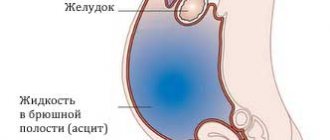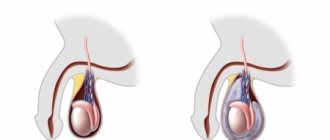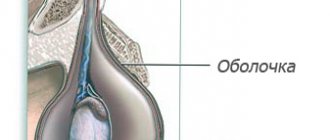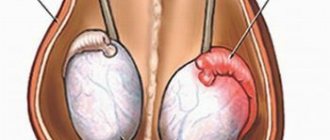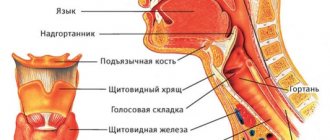Classification of the disease
Hydrocele can be isolated or communicating:
- Communicating hydrocele is a congenital type of pathology and is observed in newborns. It is characterized by the presence of a duct between the abdominal cavity and the scrotum. In this case, there is free circulation of peritoneal fluid and its accumulation in large quantities in the scrotum. Such dropsy can become isolated.
- Isolated - peritoneal fluid is not formed in the abdominal cavity, but directly in the scrotum. Most often the disease is one-sided.
The disease is divided into congenital and acquired. The congenital form up to 1-1.5 years is considered physiological and often goes away on its own without medical intervention. Acquired dropsy is the result of injury, previous infections, etc.
According to the mechanism of development, primary and secondary hydrocele are distinguished. The primary is related to the anatomical features of the boy’s body. Secondary dropsy occurs due to another disease, condition, or injury.
Caring for a newborn boy: bathing
Caring for a newborn up to six months of age involves daily bathing. In the future, you can bathe the baby every other day or even two. Bathing is intended, first of all, not to cleanse dirt (a baby who cannot walk or crawl does not get particularly dirty yet), but to wash away the waste products of the sebaceous and sweat glands from the skin and give it the opportunity to breathe fully.
At the beginning of life, a newborn has a neutral skin pH and is therefore very vulnerable to bacteria and external influences. Only by six months the environment becomes more acidic and a protective glycolipid mantle forms on the skin. It should be protected from excessive use of detergents and maintained by lubricating the skin with natural oils. Olive, almond and other natural oils have a composition similar to that of sebum, so they easily penetrate deep into the skin and saturate it with beneficial substances that increase its protection. After each bath, you can carefully lubricate all the folds of the newborn’s skin with a thin layer of sterile hygienic oil, baby cream or milk. Close attention should be paid to the area behind the ears, where the delicate skin often gets wet and crusts form. After six months, you can moisturize your baby’s skin as needed.
Herbal medicine - the use of herbal decoctions - is at your discretion, just do not forget the fact that recently more and more babies are born with a predisposition to allergies.
| This is important to know! For diaper rash, especially associated with erosion, the skin should not be treated with oils, creams and alcohol-containing solutions. It is necessary to consult a pediatrician, he will select special disinfectants and drying agents. You can return to moisturizing your skin when your skin stops getting wet. You should also know that diaper rash in the perineal area is not necessarily a consequence of improper care. This may be the first symptom of atopic dermatitis. Consult a pediatrician or pediatric dermatologist (for an appointment call: +7 (495) 229–44–10, +7 (495) 954–00–46). |
Causes of the disease
Acquired dropsy:
- injury;
- tumor;
- inflammation;
- complication of various diseases;
- previous infection;
- severe vascular and heart diseases;
- the result of unsuccessful surgery;
- performing peritoneal dialysis;
- testicular torsion;
- disturbances in the functioning of the lymphatic system, resulting in the formation of excess lymph that accumulates in the membranes of the testicles.
Congenital hydrocele:
- birth injury;
- pathologies during pregnancy;
- prematurity;
- developmental anomalies in infants;
- infection suffered by the expectant mother during pregnancy;
- abdominal wall defects;
- risk of miscarriage;
- location of the testicles outside the scrotum;
- hypospadias (penis malformation);
- non-fusion of the vaginal process.
Causes of isolated dropsy:
- Anomalies in the fusion of the inner membrane of the testicles. Normally, it should turn into connective tissue that cannot produce fluid. If the fusion occurs incorrectly, then the gap between the abdominal cavity and the scrotum disappears. However, the inner lining of the testicle can produce fluid, just like the peritoneum. The fluid cannot drain into the abdominal cavity and accumulates in the scrotum.
Causes of communicating hydrocele:
- An anatomical feature of the development of the scrotum, in which the canal between the abdominal cavity and the scrotum does not heal. As a result, fluid circulates into the scrotum.
Primary hydrocele appears without concomitant pathology and is the result of structural features of the body. Secondary dropsy develops due to infection, injury, disruption of the processes of reabsorption and filtration of fluid produced by the vaginal membrane. Such pathologies are usually caused by testicular torsion, tumors of the appendages and testicles, complications of influenza, ARVI, mumps, and surgery for a hernia.
The appearance of dropsy is promoted by increased intra-abdominal pressure. In early childhood, it occurs against the background of colic, constipation, and crying. In older boys - when lifting heavy objects, physical activity, severe coughing, straining during bowel movements.
Treatment of testicular torsion
When torsion occurs, irreversible changes occur within 6–8 hours, so immediate emergency medical care is required. In mild cases, closed detorsion (turning the testicle through the skin of the scrotum) helps. More severe cases require surgery. If too much time has passed and the tissue of the testicle has died, only its removal will help.
If treatment is carried out in a timely manner, the prognosis is good. Detorsion done in the first 6 hours after torsion leads to complete recovery in 90% of cases. If more than a day has passed, then, most likely, you will have to resort to orchiectomy.
Testicular detorsion closed
In the early stages of pathology development, conservative treatment - closed testicular detorsion - can help. This is the rotation of the testicle in the right direction, carried out without incisions, through the skin of the scrotum. It may be necessary to repeat the manipulation more than once. If the reversal is successful, the pain goes away or is greatly reduced. The testicle descends to the bottom of the scrotum and occupies an equal position with the other.
However, detorsion is not a panacea. Even if it led to success and eliminated the symptoms, it is necessary to fix the testicle to the bottom of the scrotum as soon as possible. Otherwise, a relapse is possible.
If it is impossible to quickly perform fixation after detorsion, drugs are prescribed to increase microcirculation, and novocaine blockades of the spermatic cord are performed.
Completely conservative therapy for testicular torsion is dangerous due to the accumulation of sperm antibodies in the patient’s body (after all, the blood-testis barrier is broken during torsion), damage to the other testicle and infertility. Therefore, all patients after detorsion are prescribed heparin, aspirin, and occasionally steroids.
Open testicular detorsion
If it happens that detorsion fails, or testicular torsion exists for a long time, emergency surgical intervention is needed. After a skin incision, the condition of the testicle is inspected and open detorsion is performed, then the organ is fixed to the bottom of the scrotum. If the audit showed an unsatisfactory condition of the testicle due to a long lack of blood circulation, they resort to warming the organ with a warm isotonic solution, and a mixture of antispasmodic and analgesic, as well as a hemostatic drug, is poured into the spermatic cord.
If this does not help or signs of necrosis are clearly visible, the testicle is removed (orchiectomy).
Symptoms and signs of hydrocele
This disease is usually discovered by parents when examining their child. They notice an enlargement of the scrotum on both sides or one. The volume may vary depending on the position of the body.
The disease usually resolves without pain or inflammation . However, when dropsy becomes infected, body temperature may rise, the skin may turn red, and general discomfort may occur. Sometimes children have difficulty urinating. An older child may complain of discomfort when walking, a feeling of heaviness and fullness. Dropsy is often accompanied by inguinal and abdominal hernias. Source: https://www.ncbi.nlm.nih.gov/pubmed/12378019 Han CH, Kang SH Epididymal anomalies associated with patent processus vaginalis in hydrocele and cryptorchidism // J Korean Med Sci. 2002 Oct;17(5):660-2
In advanced cases, several liters of water may accumulate in the scrotum. With the reported form of pathology, the size of the scrotum may change during the day. After a night's sleep, fluid drains into the abdominal cavity, causing the testicles to shrink. In the evening it returns, and the scrotum increases to its maximum size. Isolated dropsy is not accompanied by changes in the size of the scrotum.
Small children cannot talk about their feelings. Crying for no reason, nervous and restless behavior can indicate discomfort. Older children complain of discomfort in the initial stages, and then of a nagging or dull pain. Children over 8 years of age may complain that the scrotum has changed structure - it has become dense, and it is not possible to palpate the testicle.
Complications of dropsy
Infertility. Impaired spermatogenesis - one of the most common causes of infertility can be a consequence of impaired blood microcirculation and temperature due to the pressure of excess fluid in the testicles.
Hernias (inguinal or inguinoscrotal). With a communicating form of dropsy, the unclosed lumen of the vaginal process of the peritoneum can gradually increase and turn into a hernia.
Pain syndrome. Pain, which can become a serious psychological problem for a child, is uncommon with dropsy. The exception is acute hydrocele with a significant increase in testicular volume.
Methods for diagnosing the disease
A boy with such a problem should be shown to a pediatric urologist. At the initial consultation, the doctor collects an anamnesis of the child’s life and information about the course of his mother’s pregnancy. Then he examines the boy in a lying and upright position. This allows you to distinguish communicating dropsy from isolated dropsy. After this, the small patient needs to undergo an examination, which consists of the following procedures:
- Diaphanoscopy - transillumination of the scrotum with a special flashlight. If the disease is not complicated, the testicular membranes have a uniform color.
- Ultrasound of the groin area, which allows you to see the presence of a reported type of disease, determine the exact amount of fluid, and exclude tumors and other diseases of the scrotum.
- Scrotal biopsy – indicated when there is doubt about the diagnosis. With its help, the structure of the selected area is studied at the cellular level, malignant processes or benign formations are identified.
- A general blood test makes it possible to exclude infection and inflammation.
What complications can occur during surgery?
Common complications are possible, as with any operation:
- pain
- bleeding
- unsightly scarring of the skin
- infection of the surgical site (wound)
- allergic reaction to equipment, materials or medications
Specific complications of this operation:
- accumulation of blood or fluid under a wound or in the scrotum
- damage to the nerves that supply the skin around the groin
- disturbance of blood supply to the testicle
- vascular damage
How to treat hydrocele? Operative and conservative methods
Whether a child requires surgery depends on the shape of the testicular hydrocele. If the pathology is congenital, then a wait-and-see approach is usually chosen under the supervision of a doctor. In 80-85% of cases, the disease goes away on its own in the first 1.5 years of life.
In the acute form of hydrocele, the underlying disease that caused the hydrocele is treated. In the case of a severe form of the disease, a puncture is performed and the fluid is removed, but this gives only temporary relief, because the cause of the accumulation of water must be eliminated. Source: A.V. Grinev, S.I. Nikolaev, V.E. Serdyutsky, D. S. Efremenkov New technologies in the treatment of hydrocele in adults and children // Bulletin of the Smolensk State Medical Academy, 2003, No. 5
Treatment without surgery: clinical recommendations
An operation to remove testicular hydrocele is the only way to eliminate this pathology in a child. Doctors warn that folk remedies and dietary supplements can produce unpredictable effects. Only those children who have recovered by the time they reach 1.5 years of age can do without surgery.
Of course, many parents are afraid that the boy will remain infertile due to the presence of such a disease. Yes, overheating of the testicles can disrupt their hormonal function and reduce sperm quality. However, in early childhood (up to 3 years old) this is not critical, because all body systems are still just forming and starting to work correctly. If the doctor suggests observing the child and not performing surgery for now, do not be alarmed, because this is generally accepted practice.
Caring for a newborn: intimate hygiene
Almost every mother of a newborn boy has three main questions:
- To wash or not to wash your baby after every diaper change?
- Should I open the foreskin of the glans penis while washing?
- Is it harmful for a child to wear diapers?
Let's answer them in order:
To wash or not to wash – that is the question
Caring for a newborn boy necessarily includes washing. Boys should be washed no less often than girls! That is, every 2-3 hours or with every diaper change. Unlike girls, boys can be washed in any direction, even from front to back, even vice versa, you can’t just do it in the pelvis (after defecation). Residues of enzymes and undigested food can cause infection of the genitourinary organs and irritation of the perineum, leading to diaper rash. Therefore, you only need to wash the boy with running water. And after washing, do not rush to put on a diaper and dry the skin properly. The more air baths your baby takes, the better for his skin! It is not recommended to use soap, solutions of soda and potassium permanganate and other detergents when washing, so as not to deprive the baby’s skin of the protective glycolipid mantle. After washing, inguinal folds and irritated areas can be lubricated with hygienic oil - olive, almond (sold at the pharmacy). The scrotum and penis do not need to be lubricated.
| This is important to know! If the appearance of the penis makes you wary: for example, it is red, swollen, or inflates when urinating, contact a pediatric urologist immediately. |
Failure to comply with the rules of intimate hygiene in a newborn boy can lead to balanoposthitis (inflammation of the glans penis) and a stage of phimosis (growth of the foreskin), which can only be corrected surgically. Inflammation of the genital organs suffered by a boy in childhood can result in infertility, impotence, prostatitis and other unpleasant problems in adulthood. Proper care of a newborn boy is the key to his good male health in the future.
Foreskin: to open or not to open the head of the penis?
Modern, progressive doctors strongly recommend leaving the foreskin of boys until they are 5–6 years old alone. At an earlier age, the inner surface of the foreskin is still firmly connected to the head of the penis. This phenomenon is absolutely normal; in medical language it is called physiological phimosis. Premature shifting of the baby's foreskin leads to the formation of small wounds, which, when healing, leave scars, which leads to an even greater narrowing of the foreskin.
| This is important to know! If your baby has been circumcised, the penis will be red and produce a yellowish secretion for the first week. Make sure that the redness gradually disappears and that a weeping yellow crust does not form on the head of the penis. If this happens, contact a pediatric urologist immediately. |
Diapers: yes or no?
There is an opinion that constantly wearing diapers overheats the baby’s genitals, disrupting their natural formation and the process of sperm production. Studies were conducted at the Scientific Center for Children's Health, which showed that an increase in temperature by 2 ºС due to the use of diapers does not affect sexual function and the formation of the genital organs. This is also supported by the fact that a generation of children has already matured who grew up in diapers, but at the same time successfully have their own babies (although the percentage of primary male infertility has definitely increased these days, no matter what causes it). But experienced experts still recommend not keeping your baby in diapers all the time.
Sometimes a baby becomes allergic to a diaper, or rather, not to the diaper itself, but to the materials from which it is made. This doesn't mean you need to give up diapers altogether. Just change the manufacturer and always make sure that the diaper matches the baby's weight. For allergies in newborns, it is very good to use “natural baby swaddling systems.” At the first stage of their use, they require a little more time to learn than regular disposable diapers, but later, once you get used to them, you will appreciate that, firstly, they are more environmentally friendly, and secondly, in the end they are cheaper to use than disposable ones.
When is surgery needed and how is it performed?
When acute dropsy appears against the background of another disease or injury, surgery is performed. In addition, surgical intervention is indicated when puncture has no effect and fluid continues to accumulate. Four different operations are performed to treat children - Lord's, Ross's, Winkelmann's and Bergmann's.
Bergman's operation
Indicated for large-scale accumulation of fluid in the scrotum. Complete excision of the vaginal membrane, removal of lymph with a syringe, and suturing of the scrotal membranes are expected. In early childhood, this operation is not performed because the testicles need to be fully formed.
Most often, for hydrocele in children, Ross and Winkelmann operations are performed.
Operation Ross
A small incision is made in the groin and the canal between the scrotum and the abdominal cavity is sutured through it. The Ross operation is indicated for congenital communicating hydrocele. The procedure lasts about 30 minutes and general anesthesia is used. After surgery for hydrocele, children are advised to limit physical activity and not to wet the surgical wound. After 1-2 weeks, the stitches are removed.
Winkelmann operation
This operation is performed if the disease is caused by the fact that the lymphatic system produces excess lymph, which overflows the testicular membrane. An incision is made on the front of the scrotum. The testicle is removed, the lymph is removed through the dissected membrane. In this case, the shell is turned inside out and stitched in this position. As a result, excess lymph is no longer formed - it is absorbed into the connective tissue.
Operation Ross
Operation according to the Ross technique is an effective way to treat communicating hydrops in children over two years of age. It is valued for its almost complete absence of contraindications, minimal postoperative scars and speed of implementation (within 40 minutes). During the operation, the processus vaginalis of the peritoneum is ligated in two places and excised, after which a special hole is formed to remove excess fluid. As a rule, the patient can leave the hospital within a few hours after the intervention.
Prevention methods
It is necessary to take measures to prevent inflammation of the scrotum. Parents should regularly examine their child's genitals and contact a doctor immediately if they notice any swelling. Those children who have a congenital disease should be regularly monitored by a pediatric urologist.
Sources:
- https://www.ncbi.nlm.nih.gov/pubmed/12378019 Han CH, Kang SH. Epididymal anomalies associated with patent processus vaginalis in hydrocele and cryptorchidism // J Korean Med Sci. 2002 Oct;17(5):660-2.
- A.V. Grinev, S.I. Nikolaev, V.E. Serdyutsky, D. S. Efremenkov. New technologies in the treatment of hydrocele in adults and children // Bulletin of the Smolensk State Medical Academy, 2003, No. 5.
The information in this article is provided for reference purposes and does not replace advice from a qualified professional. Don't self-medicate! At the first signs of illness, you should consult a doctor.
Postoperative care at home
For pain relief, paracetamol may be given according to package directions for the first three to five days after surgery to reduce discomfort. It is unacceptable to give children aspirin.
The child can eat and drink when he feels well. It is not uncommon for children to vomit the night after surgery. If your child is vomiting, give him a sip of clear liquid, a piece of dry toast or a biscuit cracker, and increase the dose as much as possible until the vomiting stops. If vomiting continues 24 hours after surgery, you should seek medical attention.
Swimming is allowed seven days after surgery or as recommended by the surgeon.
Take your child to the doctor if there is excessive vomiting, persistent high fever, or severe pain that is not relieved by paracetamol.
Prices
| Name of service (price list incomplete) | Price |
| Appointment (examination, consultation) with a pediatric urologist-andrologist, primary, therapeutic and diagnostic, outpatient | 1750 rub. |
| Consultation (interpretation) with analyzes from third parties | 2250 rub. |
| Prescription of treatment regimen (for up to 1 month) | 1800 rub. |
| Prescription of treatment regimen (for a period of 1 month) | 2700 rub. |
| Consultation with a candidate of medical sciences | 2500 rub. |
| Kidney ultrasound | 1700 rub. |
